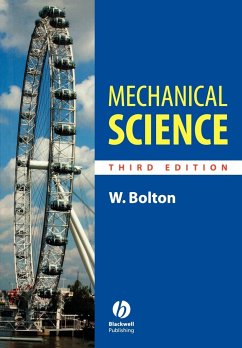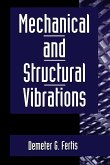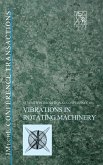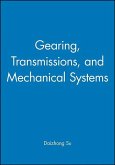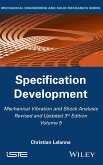W C Bolton
Mechanical Science
W C Bolton
Mechanical Science
- Broschiertes Buch
- Merkliste
- Auf die Merkliste
- Bewerten Bewerten
- Teilen
- Produkt teilen
- Produkterinnerung
- Produkterinnerung
This book gives comprehensive coverage of mechanical science for HNC/HND students taking mechanical engineering courses, including all topics likely to be covered in both years of such courses, as well as for first year undergraduate courses in mechanical engineering. It features 500 problems with answers and 200 worked examples. The third edition includes a new section on power transmission and an appendix on mathematics to help students with the basic notation of calculus and solution of differential equations.
Andere Kunden interessierten sich auch für
![Mechanical and Structural Vibrations Mechanical and Structural Vibrations]() Demeter G FertisMechanical and Structural Vibrations264,99 €
Demeter G FertisMechanical and Structural Vibrations264,99 €![Vibrations in Rotating Machinery Vibrations in Rotating Machinery]() Pep (Professional Engineering Publishers)Vibrations in Rotating Machinery575,99 €
Pep (Professional Engineering Publishers)Vibrations in Rotating Machinery575,99 €![Gearing, Transmissions, and Mechanical Systems Gearing, Transmissions, and Mechanical Systems]() Gearing, Transmissions, and Mechanical Systems1.001,99 €
Gearing, Transmissions, and Mechanical Systems1.001,99 €![Fluid Sealing Fluid Sealing]() Fluid Sealing1.001,99 €
Fluid Sealing1.001,99 €![Mechanical Vibrations Mechanical Vibrations]() Tomasz KrysinskiMechanical Vibrations281,99 €
Tomasz KrysinskiMechanical Vibrations281,99 €![Mechanical Vibration and Shock Analysis, Specification Development Mechanical Vibration and Shock Analysis, Specification Development]() Christian LalanneMechanical Vibration and Shock Analysis, Specification Development253,99 €
Christian LalanneMechanical Vibration and Shock Analysis, Specification Development253,99 €![Thermal Design and Optimization Thermal Design and Optimization]() Adrian BejanThermal Design and Optimization200,99 €
Adrian BejanThermal Design and Optimization200,99 €-
-
-
This book gives comprehensive coverage of mechanical science for HNC/HND students taking mechanical engineering courses, including all topics likely to be covered in both years of such courses, as well as for first year undergraduate courses in mechanical engineering. It features 500 problems with answers and 200 worked examples. The third edition includes a new section on power transmission and an appendix on mathematics to help students with the basic notation of calculus and solution of differential equations.
Hinweis: Dieser Artikel kann nur an eine deutsche Lieferadresse ausgeliefert werden.
Hinweis: Dieser Artikel kann nur an eine deutsche Lieferadresse ausgeliefert werden.
Produktdetails
- Produktdetails
- Verlag: Wiley
- 3rd Revised edition
- Seitenzahl: 496
- Erscheinungstermin: 24. Februar 2006
- Englisch
- Abmessung: 244mm x 170mm x 27mm
- Gewicht: 851g
- ISBN-13: 9781405137942
- ISBN-10: 1405137940
- Artikelnr.: 21629640
- Herstellerkennzeichnung
- Libri GmbH
- Europaallee 1
- 36244 Bad Hersfeld
- gpsr@libri.de
- Verlag: Wiley
- 3rd Revised edition
- Seitenzahl: 496
- Erscheinungstermin: 24. Februar 2006
- Englisch
- Abmessung: 244mm x 170mm x 27mm
- Gewicht: 851g
- ISBN-13: 9781405137942
- ISBN-10: 1405137940
- Artikelnr.: 21629640
- Herstellerkennzeichnung
- Libri GmbH
- Europaallee 1
- 36244 Bad Hersfeld
- gpsr@libri.de
Former Head of Research, Development and Monitoring at BTEC
Preface. Chapter 1 Forces and equilibrium
1.1 Scalars and vectors
1.2 Force as a vector
1.3 Non-concurrent forces
1.4 Free-body diagrams
1.5 Forces in equilibrium
Problems
Chapter 2 Simple stress and strain
2.1 Stress and strain
2.2 Thermal stresses
2.3 Composite bars
2.4 Poisson's ratio
2.5 Bulk modulus
Problems
Chapter 3 Beams
3.1 Types of beams
3.2 Bending moment and shearing force
3.3 Bending stresses
3.4 Second moment of area
3.5 Section modulus
3.6 Combined bending and direct stresses
3.7 Shear stresses due to bending
3.8 Composite beams
3.9 Plastic bending
Problems
Chapter 4 Deflections of beams
4.1 The deflection curve
4.2 Deflections by double-integration
4.3 Moment-area method
4.4 Macaulay's method
4.5 Statically-indeterminate beams
Problems
Chapter 5 Struts and columns
5.1 Buckling
5.2 Euler's equation
5.3 Limitations of Euler's equation
Problems
Chapter 6 Torsion
6.1 Torsion of circular shafts
6.2 Transmission of power
6.3 Compound shafts
Problems
Chapter 7 Strain energy
7.1 Strain energy
7.2 Strain energy in axially loaded bars
7.3 Dynamic loading
7.4 Strain energy due to shear
7.5 Impact torsional loading
7.6 Strain energy due to bending
7.7 Impact loading of beams
7.8 Strain energy due to combined loading
7.9 Castigliano's theorem
Problems
Chapter 8 Stress and strain analysis
8.1 Complex stress situations
8.2 Simple tension
8.3 Biaxial stress system
8.4 General two-dimensional stress system
8.5 Mohr's stress circle
8.6 Principal strains and stresses
8.7 Plane strain
8.8 Theories of failure
8.9 Elastic constants
Problems
Chapter 9 Cylindrical shells
9.1 Thin cylindrical shell
9.2 Thin spherical shell
9.3 Volume changes of shells
9.4 Thick cylindrical shell
9.5 Compound tube
Problems
Chapter 10 Linear and angular motion
10.1 Linear motion
10.2 Curvilinear motion
10.3 Relative velocity
10.4 Angular motion
10.5 Torque and angular motion
10.6 Balancing of rotating masses
10.7 Momentum
10.8 Work and energy
Problems
Chapter 11 Mechanisms
11.1 Mechanisms
11.2 Velocity diagrams
11.3 Acceleration diagrams
11.4 Reciprocating mechanisms
Problems
Chapter 12 Turning moment diagrams
12.1 Crank effort diagrams
12.2 Fluctuations of speed and energy
12.3 Flywheels
Problems
Chapter 13 Power transmission
13.1 Machines and some basic definitions
13.2 Transmission of rotational motion
13.3 Geared systems
13.4 Gear trains
13.5 Epicyclic gear trains
13.6 Torques on gear trains
Problems
Chapter 14 Friction clutches, bearings and belt drives
14.1 Friction
14.2 Friction clutches
14.3 Bearings
14.4 Belt drives
Problems
Chapter 15 Gyroscopic motion
15.1 Vectors
15.2 Gyroscopic couple
Problems
Chapter 16 Free vibration
16.1 Simple harmonic motion
16.2 Linear vibrations of an elastic system
16.3 Torsional vibrations of an elastic system
16.4 Transverse vibrations of beams
16.5 Whirling of shafts
Problems
Chapter 17 Damped and forced oscillations
17.1 Free oscillations
17.2 Damped oscillations
17.3 Undamped forced oscillations
17.4 Damped forced oscillations
Problems
Chapter 18 Vibrations of multi-degree systems
18.1 Degrees of freedom
18.2 Coupled pendulums
18.3 Two rotor system
18.4 Forced vibrations
18.5 Systems with many degrees of freedom
Problems
Chapter 19 Finite element method
19.1 The finite element method
19.2 The analysis of simple rod elements
19.2 Local and global coordinates
Problems
Appendix: Some mathematics help
Answers to problems
Index
1.1 Scalars and vectors
1.2 Force as a vector
1.3 Non-concurrent forces
1.4 Free-body diagrams
1.5 Forces in equilibrium
Problems
Chapter 2 Simple stress and strain
2.1 Stress and strain
2.2 Thermal stresses
2.3 Composite bars
2.4 Poisson's ratio
2.5 Bulk modulus
Problems
Chapter 3 Beams
3.1 Types of beams
3.2 Bending moment and shearing force
3.3 Bending stresses
3.4 Second moment of area
3.5 Section modulus
3.6 Combined bending and direct stresses
3.7 Shear stresses due to bending
3.8 Composite beams
3.9 Plastic bending
Problems
Chapter 4 Deflections of beams
4.1 The deflection curve
4.2 Deflections by double-integration
4.3 Moment-area method
4.4 Macaulay's method
4.5 Statically-indeterminate beams
Problems
Chapter 5 Struts and columns
5.1 Buckling
5.2 Euler's equation
5.3 Limitations of Euler's equation
Problems
Chapter 6 Torsion
6.1 Torsion of circular shafts
6.2 Transmission of power
6.3 Compound shafts
Problems
Chapter 7 Strain energy
7.1 Strain energy
7.2 Strain energy in axially loaded bars
7.3 Dynamic loading
7.4 Strain energy due to shear
7.5 Impact torsional loading
7.6 Strain energy due to bending
7.7 Impact loading of beams
7.8 Strain energy due to combined loading
7.9 Castigliano's theorem
Problems
Chapter 8 Stress and strain analysis
8.1 Complex stress situations
8.2 Simple tension
8.3 Biaxial stress system
8.4 General two-dimensional stress system
8.5 Mohr's stress circle
8.6 Principal strains and stresses
8.7 Plane strain
8.8 Theories of failure
8.9 Elastic constants
Problems
Chapter 9 Cylindrical shells
9.1 Thin cylindrical shell
9.2 Thin spherical shell
9.3 Volume changes of shells
9.4 Thick cylindrical shell
9.5 Compound tube
Problems
Chapter 10 Linear and angular motion
10.1 Linear motion
10.2 Curvilinear motion
10.3 Relative velocity
10.4 Angular motion
10.5 Torque and angular motion
10.6 Balancing of rotating masses
10.7 Momentum
10.8 Work and energy
Problems
Chapter 11 Mechanisms
11.1 Mechanisms
11.2 Velocity diagrams
11.3 Acceleration diagrams
11.4 Reciprocating mechanisms
Problems
Chapter 12 Turning moment diagrams
12.1 Crank effort diagrams
12.2 Fluctuations of speed and energy
12.3 Flywheels
Problems
Chapter 13 Power transmission
13.1 Machines and some basic definitions
13.2 Transmission of rotational motion
13.3 Geared systems
13.4 Gear trains
13.5 Epicyclic gear trains
13.6 Torques on gear trains
Problems
Chapter 14 Friction clutches, bearings and belt drives
14.1 Friction
14.2 Friction clutches
14.3 Bearings
14.4 Belt drives
Problems
Chapter 15 Gyroscopic motion
15.1 Vectors
15.2 Gyroscopic couple
Problems
Chapter 16 Free vibration
16.1 Simple harmonic motion
16.2 Linear vibrations of an elastic system
16.3 Torsional vibrations of an elastic system
16.4 Transverse vibrations of beams
16.5 Whirling of shafts
Problems
Chapter 17 Damped and forced oscillations
17.1 Free oscillations
17.2 Damped oscillations
17.3 Undamped forced oscillations
17.4 Damped forced oscillations
Problems
Chapter 18 Vibrations of multi-degree systems
18.1 Degrees of freedom
18.2 Coupled pendulums
18.3 Two rotor system
18.4 Forced vibrations
18.5 Systems with many degrees of freedom
Problems
Chapter 19 Finite element method
19.1 The finite element method
19.2 The analysis of simple rod elements
19.2 Local and global coordinates
Problems
Appendix: Some mathematics help
Answers to problems
Index
Preface. Chapter 1 Forces and equilibrium
1.1 Scalars and vectors
1.2 Force as a vector
1.3 Non-concurrent forces
1.4 Free-body diagrams
1.5 Forces in equilibrium
Problems
Chapter 2 Simple stress and strain
2.1 Stress and strain
2.2 Thermal stresses
2.3 Composite bars
2.4 Poisson's ratio
2.5 Bulk modulus
Problems
Chapter 3 Beams
3.1 Types of beams
3.2 Bending moment and shearing force
3.3 Bending stresses
3.4 Second moment of area
3.5 Section modulus
3.6 Combined bending and direct stresses
3.7 Shear stresses due to bending
3.8 Composite beams
3.9 Plastic bending
Problems
Chapter 4 Deflections of beams
4.1 The deflection curve
4.2 Deflections by double-integration
4.3 Moment-area method
4.4 Macaulay's method
4.5 Statically-indeterminate beams
Problems
Chapter 5 Struts and columns
5.1 Buckling
5.2 Euler's equation
5.3 Limitations of Euler's equation
Problems
Chapter 6 Torsion
6.1 Torsion of circular shafts
6.2 Transmission of power
6.3 Compound shafts
Problems
Chapter 7 Strain energy
7.1 Strain energy
7.2 Strain energy in axially loaded bars
7.3 Dynamic loading
7.4 Strain energy due to shear
7.5 Impact torsional loading
7.6 Strain energy due to bending
7.7 Impact loading of beams
7.8 Strain energy due to combined loading
7.9 Castigliano's theorem
Problems
Chapter 8 Stress and strain analysis
8.1 Complex stress situations
8.2 Simple tension
8.3 Biaxial stress system
8.4 General two-dimensional stress system
8.5 Mohr's stress circle
8.6 Principal strains and stresses
8.7 Plane strain
8.8 Theories of failure
8.9 Elastic constants
Problems
Chapter 9 Cylindrical shells
9.1 Thin cylindrical shell
9.2 Thin spherical shell
9.3 Volume changes of shells
9.4 Thick cylindrical shell
9.5 Compound tube
Problems
Chapter 10 Linear and angular motion
10.1 Linear motion
10.2 Curvilinear motion
10.3 Relative velocity
10.4 Angular motion
10.5 Torque and angular motion
10.6 Balancing of rotating masses
10.7 Momentum
10.8 Work and energy
Problems
Chapter 11 Mechanisms
11.1 Mechanisms
11.2 Velocity diagrams
11.3 Acceleration diagrams
11.4 Reciprocating mechanisms
Problems
Chapter 12 Turning moment diagrams
12.1 Crank effort diagrams
12.2 Fluctuations of speed and energy
12.3 Flywheels
Problems
Chapter 13 Power transmission
13.1 Machines and some basic definitions
13.2 Transmission of rotational motion
13.3 Geared systems
13.4 Gear trains
13.5 Epicyclic gear trains
13.6 Torques on gear trains
Problems
Chapter 14 Friction clutches, bearings and belt drives
14.1 Friction
14.2 Friction clutches
14.3 Bearings
14.4 Belt drives
Problems
Chapter 15 Gyroscopic motion
15.1 Vectors
15.2 Gyroscopic couple
Problems
Chapter 16 Free vibration
16.1 Simple harmonic motion
16.2 Linear vibrations of an elastic system
16.3 Torsional vibrations of an elastic system
16.4 Transverse vibrations of beams
16.5 Whirling of shafts
Problems
Chapter 17 Damped and forced oscillations
17.1 Free oscillations
17.2 Damped oscillations
17.3 Undamped forced oscillations
17.4 Damped forced oscillations
Problems
Chapter 18 Vibrations of multi-degree systems
18.1 Degrees of freedom
18.2 Coupled pendulums
18.3 Two rotor system
18.4 Forced vibrations
18.5 Systems with many degrees of freedom
Problems
Chapter 19 Finite element method
19.1 The finite element method
19.2 The analysis of simple rod elements
19.2 Local and global coordinates
Problems
Appendix: Some mathematics help
Answers to problems
Index
1.1 Scalars and vectors
1.2 Force as a vector
1.3 Non-concurrent forces
1.4 Free-body diagrams
1.5 Forces in equilibrium
Problems
Chapter 2 Simple stress and strain
2.1 Stress and strain
2.2 Thermal stresses
2.3 Composite bars
2.4 Poisson's ratio
2.5 Bulk modulus
Problems
Chapter 3 Beams
3.1 Types of beams
3.2 Bending moment and shearing force
3.3 Bending stresses
3.4 Second moment of area
3.5 Section modulus
3.6 Combined bending and direct stresses
3.7 Shear stresses due to bending
3.8 Composite beams
3.9 Plastic bending
Problems
Chapter 4 Deflections of beams
4.1 The deflection curve
4.2 Deflections by double-integration
4.3 Moment-area method
4.4 Macaulay's method
4.5 Statically-indeterminate beams
Problems
Chapter 5 Struts and columns
5.1 Buckling
5.2 Euler's equation
5.3 Limitations of Euler's equation
Problems
Chapter 6 Torsion
6.1 Torsion of circular shafts
6.2 Transmission of power
6.3 Compound shafts
Problems
Chapter 7 Strain energy
7.1 Strain energy
7.2 Strain energy in axially loaded bars
7.3 Dynamic loading
7.4 Strain energy due to shear
7.5 Impact torsional loading
7.6 Strain energy due to bending
7.7 Impact loading of beams
7.8 Strain energy due to combined loading
7.9 Castigliano's theorem
Problems
Chapter 8 Stress and strain analysis
8.1 Complex stress situations
8.2 Simple tension
8.3 Biaxial stress system
8.4 General two-dimensional stress system
8.5 Mohr's stress circle
8.6 Principal strains and stresses
8.7 Plane strain
8.8 Theories of failure
8.9 Elastic constants
Problems
Chapter 9 Cylindrical shells
9.1 Thin cylindrical shell
9.2 Thin spherical shell
9.3 Volume changes of shells
9.4 Thick cylindrical shell
9.5 Compound tube
Problems
Chapter 10 Linear and angular motion
10.1 Linear motion
10.2 Curvilinear motion
10.3 Relative velocity
10.4 Angular motion
10.5 Torque and angular motion
10.6 Balancing of rotating masses
10.7 Momentum
10.8 Work and energy
Problems
Chapter 11 Mechanisms
11.1 Mechanisms
11.2 Velocity diagrams
11.3 Acceleration diagrams
11.4 Reciprocating mechanisms
Problems
Chapter 12 Turning moment diagrams
12.1 Crank effort diagrams
12.2 Fluctuations of speed and energy
12.3 Flywheels
Problems
Chapter 13 Power transmission
13.1 Machines and some basic definitions
13.2 Transmission of rotational motion
13.3 Geared systems
13.4 Gear trains
13.5 Epicyclic gear trains
13.6 Torques on gear trains
Problems
Chapter 14 Friction clutches, bearings and belt drives
14.1 Friction
14.2 Friction clutches
14.3 Bearings
14.4 Belt drives
Problems
Chapter 15 Gyroscopic motion
15.1 Vectors
15.2 Gyroscopic couple
Problems
Chapter 16 Free vibration
16.1 Simple harmonic motion
16.2 Linear vibrations of an elastic system
16.3 Torsional vibrations of an elastic system
16.4 Transverse vibrations of beams
16.5 Whirling of shafts
Problems
Chapter 17 Damped and forced oscillations
17.1 Free oscillations
17.2 Damped oscillations
17.3 Undamped forced oscillations
17.4 Damped forced oscillations
Problems
Chapter 18 Vibrations of multi-degree systems
18.1 Degrees of freedom
18.2 Coupled pendulums
18.3 Two rotor system
18.4 Forced vibrations
18.5 Systems with many degrees of freedom
Problems
Chapter 19 Finite element method
19.1 The finite element method
19.2 The analysis of simple rod elements
19.2 Local and global coordinates
Problems
Appendix: Some mathematics help
Answers to problems
Index

